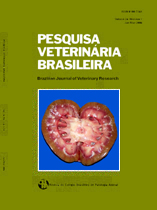 |
|
|
|
Year 2012 - Volume 32, Number 9
|

|
Risk factors associated with the squamous cell carcinoma occurrence in ruminants and equine in the semiarid of the Paraíba, 32(9):881-886
|
ABSTRACT.- Carvalho F.K.L., Dantas A.F.M., Riet-Correa F., Miranda Neto E.G., Simões S.V.D. & Azevedo S.S. 2012. [Risk factors associated with the squamous cell carcinoma occurrence in ruminants and equine in the semiarid of the Paraíba.] Fatores de risco associados à ocorrência de carcinoma de células escamosas em ruminantes e equinos no semiárido da Paraíba. Pesquisa Veterinária Brasileira 32(9):881-886. Hospital Veterinário, Laboratório de Patologia Animal, CSTR, Universidade Federal de Campina Grande, Campus de Patos, Avenida Universitária s/n, Bairro Santa Cecília, Patos, PB 58708-110, Brazil. E-mail: dantas.af@uol.com.br
This paper describes the frequency of squamous cell carcinoma (SCC) diagnosed at the Laboratory (LPA) of Animal Pathology, Veterinary Hospital of the Federal University of Campina Grande (UFCG), in cattle, sheep, goats, and horses in the semiarid region of Paraíba, Brazil, from 1983 to 2010, analyzing epidemiological data and risk factors. We performed the analysis of risk factors, by the chi-square test, considering variables such as species, breed, sex, age and location of the tumor mass. During the period, 3153 diagnoses were recorded from biopsies and necropsies. From these, 81 cases (2.7%) were squamous cell carcinomas. The frequency by species was 4% (42/1052) in cattle, 2.5% (15/603) in horses, 1.7% (12/709) in sheep, and 1.5% (12/789) in goats, being significantly higher in cattle (p<0.001). All cases showed histological features of SCC, varying only the degree of cell differentiation. In cattle and goats, the frequency of SCC was significantly higher in adult animals (p<0.001 and <0.005, respectively). In cattle the preferred location was in the eyes and periocular region (p<0.001), in sheep in the skin (p=0.018), especially the head. In other species no significant differences were found in the tumor location. It is suggested that the higher frequency of SCC in cattle is due to the constitution of the herds, formed predominantly by females of the Holstein breed. |
| |
|
|
| |
|
 |